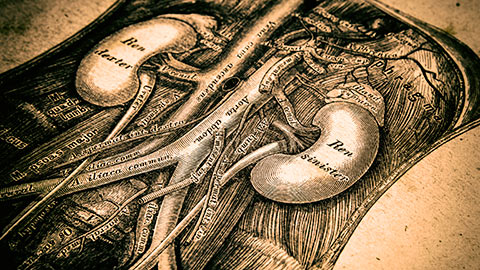
A client has a history of two heart attacks and a kidney transplant. There’s no way they can safely receive massage, right?
Maybe not.
Join us for a short exploration of the miracles of kidney transplant surgery, the pathophysiology of heart attacks, and the surprising number of options this massage therapist has to offer safe, effective bodywork to this client.
Resources: 
The ABMP Podcast Ep 75 – Kidney Donor: “I Have a Client Who …” Pathology Conversations with Ruth Werner (2021) Associated Bodywork & Massage Professionals. Available at: /podcasts/ep-75-kidney-donor-i-have-client-who-pathology-conversations-ruth-werner.
“Get Informed.” National Foundation for Transplants (no date). Available at: https://transplants.org/get-informed/
“Can You Have a Heart Attack Without Having Any Blocked Arteries?” Cleveland Clinic (2020). Available at: https://health.clevelandclinic.org/can-you-have-a-heart-attack-without-having-any-blocked-arteries/
“Organ Donation and Transplantation Statistics.” National Kidney Foundation (2014). Available at: https://www.kidney.org/news/newsroom/factsheets/Organ-Donation-and-Transplantation-Stats
Organ transplant trends: “More deceased-donor transplants than ever.” UNOS (no date). Available at: https://unos.org/data/transplant-trends/


This podcast sponsored by:
About Anatomy Trains:
Anatomy Trains is a global leader in online anatomy education and also provides in-classroom certification programs forstructuralintegration in the US, Canada, Australia, Europe, Japan, and China, as well as fresh-tissue cadaverdissectionlabs and weekend courses. The work of Anatomy Trains originated with founder Tom Myers, who mapped the human body into 13 myofascial meridians in his original book, currently in itsfourthedition and translated into 12 languages. The principles of Anatomy Trains are used by osteopaths,physicaltherapists,bodyworkers,massagetherapists,personaltrainers,yoga,Pilates,Gyrotonics,and other body-minded manual therapists and movement professionals. Anatomy Trains inspires these practitioners to work with holistic anatomy in treating system-wide patterns to provide improved client outcomes in terms of structure and function.
Website:anatomytrains.com
Email:info@anatomytrains.com
Facebook:facebook.com/AnatomyTrains
Instagram: instagram.com/anatomytrainsofficial
0:00:00.0 Speaker 1: Ruth Werner's best-selling book, A Massage Therapist's Guide to Pathology, is a highly regarded comprehensive resource that sets the standard for pathology education. Written for massage therapy students and practitioners, this groundbreaking resource serves up a comprehensive review of the pathophysiology signs, symptoms and treatment of more than 500 diseases and disorders. Learn more at booksofdiscovery.com.
0:00:32.7 Speaker 2: Anatomy Trains is delighted to announce a brand new dissection live stream specialty class on September 18th. Lumbopelvic stability, a one-day layered dissection with Anatomy Trains author Tom Myers and master dissector Todd Garcia. The early bird price of $150 is held until September 10th. After September 10th, the price is $250. Come see the body's actual core for yourself. This course will be provided over Zoom webinar with multiple camera views, live chat and Q&A. Visit anatomytrains.com to sign up.
[music]
0:01:15.0 Ruth Werner: Hi, and welcome to "I Have a Client Who, Pathology Conversations with Ruth Werner," the podcast where I will discuss your real life stories about clients with conditions that are perplexing or confusing. I'm Ruth Werner, author of A Massage Therapist's Guide to Pathology. And I have spent decades studying, writing about, and teaching about where massage therapy intersects with diseases and conditions that might limit our client's health. We almost always have something good to offer even with our most challenged clients, but we need to figure out a way to do that safely, effectively and within our scope of practice, and sometimes as we have all learned, that is harder than it looks. Today's episode comes from a massage therapist who generously allowed me to share this question with all of us. "What types of massage technique or modality can be done on a two-time heart attack patient and kidney transplant recipient besides Swedish, if even that? I've been told there's nothing we can do, but in a world full of possibilities, is there anything we can do to help?" Great question. Well, alright, so we don't have a lot of details here and I did not follow up with this person to get any more details 'cause I thought that would make kind of an interesting thought experiment.
0:02:36.9 RW: So a lot of what I'm going to share with you, I'm just extrapolating from this little bit of information about a client who has a history of two heart attacks and they are also an organ transplant recipient. We don't know the timing on this, we don't know how recent anything was or in what order these events took place? I'm going to make some assumptions based on just the limited amount of information we do have. Let's assume this client is active enough that they think receiving massage will improve their quality of life. That doesn't have to mean they are very active, but let's say this person is probably at least ambulatory and not living at a rehab center or in a hospital setting at this time. And let's assume that because they have a history of heart attack and a kidney transplant, that they probably have other conditions as well. Specifically, I'm thinking about their blood pressure and atherosclerosis, and maybe they're at risk for heart failure because that can cause kidney damage and the need for a new kidney and/or they may also have diabetes.
0:03:48.6 RW: Now, normally in, 'I Have a Client Who' I select a topic to do a bit of a deep dive into details, and on this one, I'm a little bit torn about whether to talk about heart attacks or kidney transplants. So I'm gonna do a little of both. Kidney transplants. These are amazing. I did an 'I Have a Client Who' episode on massage for kidney donors in February of 2021. If you're interested, you can find that at abmp.com/podcasts. It is episode number 75. But today we're going to talk about being a kidney recipient. So you may be aware, especially if you listened to that other episode, that you have about twice as much kidney capacity as you really need, which is why it is possible to donate one of your kidneys to someone else, and you'll probably both be fine. It also means that by the time someone needs to receive a donation, both of their kidneys are functioning way below normal levels.
0:04:55.5 RW: End-stage renal failure is the last phase of progressive loss of kidney function. Chronic high blood pressure and diabetes, which frequently go hand-in-hand, are the leading causes of end-stage renal failure. Right now in the United States, about 650,000 Americans are approaching end-stage renal failure, 468,000 people are using dialysis to supplement renal function, and dialysis is often a stop-gap solution while a person hopes to get on the transplant list which currently stands at about 82,000 people. Kidneys can be harvested from deceased donors or donated by living donors. The average waiting time on the kidney transplant list is 679 days, which is longer than many people with end-stage renal failure live. About 12 people on the transplant list die every day. In 2019, over 23,000 people got a new kidney, and that is the highest number we've ever seen in this country. It's gone slightly down since then, but it has stayed over 20,000 transplants per year.
0:06:10.7 RW: The life expectancy of a transplanted kidney is about 10 to 12 years, although transplants from living donors tend to last longer. Unless there's an infection or some other kind of severe tissue trauma, under functioning kidneys are usually left where they are during the transplant surgery. The new kidney is then implanted in the central pelvis close to the urinary bladder. Kidney transplant recipients can have close to normal life expectancy if the conditions that put them at risk in the first place, again, that's usually high blood pressure and/or diabetes. So if those conditions are under control, but they must commit to a lifetime of taking immune-suppressant drugs so they don't reject the new tissue, and that of course, creates some cautions for massage therapy, because we don't wanna put our client at risk by exposing them to any possible cooties that we might be carrying with us. But beyond that, any massage therapy that fits within this person's regular adaptive capacity, that is their ability to maintain homeostatic equilibrium, that's probably going to be safe. How do we determine what that is? By getting as accurate a picture as possible of their activities of daily living and how well they tolerate physically challenging exercise.
0:07:38.1 RW: Okay, so here's a client who has received the wonderful miraculous gift of a working kidney. This person is a walking miracle. But they've also had a history of two heart attacks. Yikes, maybe we don't know the order of events for this client, possibly the heart attacks were before the organ transplant, and I looked it up, it turns out you can get on the transplant list even with a history of heart disease if it's well controlled, so we can't draw any conclusions about that. So let's just do a brief overview of heart attacks, and then we will talk about options for this client. Heart attacks are events that happen when some portion of cardiac muscle is deprived of oxygen long enough that cells die and those myocardial cells, they don't grow back, they're replaced by scar tissue that does not have the same contractile force that the original muscle cells had. What cuts off oxygen to the heart muscle? Usually, it's a blockage in one of the arteries that surround the heart, you remember this, the coronary arteries, called that because they encircle the heart like a crown, so sometimes a heart attack is called a coronary.
0:08:53.3 RW: A bit of debris, usually a fragment of a blood clot or some atherosclerotic plaque travels downstream in a coronary artery and gets lodged and all the cells on the far side of that blockage are in trouble. If the blockage remains in place and grows instead of melting, all those cells that are downstream might die, and that patch of dead tissue is a Myocardial Infarction or an MI, but this takes some time. And something a lot of people don't really get about heart attacks is that they are dynamic, they get worse over a period of hours. And this is why early intervention is so important, the sooner a person receives care, and this could look like emergency surgery or antiplatelets or anticoagulant or thrombolytic drugs, the sooner they receive care, the less overall damage they accrue, and this is why people are counseled to maybe pop a baby aspirin, that's an anti-platelet drug while they wait for the ambulance to get to the hospital with their heart attack symptoms.
0:10:02.5 RW: Now, the clot or plaque fragments that made that blockage, they are usually due to long-term cardiovascular problems, high blood pressure and atherosclerosis. But it's possible to have a heart attack that is damage to myocardial tissue because of oxygen deprivation without a blockage, and this might occur with really severe spasms of segments of the coronary artery related to stress or drugs or some other factors, and these account for about 5% to 6% of all heart attacks. And there's another thing that looks just like a heart attack, but it's directly related to emotional responses, and part of the heart musculature, and that is called broken heart syndrome. I have a friend who had a bout of this a couple of years ago, so at some point I might do a podcast related to her experience. But let's assume that the client we're talking about has had general garden variety heart attacks related to cardiovascular disease, and let's say that the heart attacks and the kidney transplant were long enough ago that the person has returned to some level of physical activity and they'd like to receive massage. Maybe they were working in the garden and they wrenched their back from reaching too high, or maybe they over-did it at yoga and now they're sore.
0:11:24.8 RW: And with this kind of health history, is it possible to offer a safe and effective massage session? Absolutely. It might not look like the session you plan for your client who's training for a marathon or even your general full body relaxation, rigorous Swedish massage client, at least not until you know more about this person's allostatic load, the burden of wear and tear, they've accumulated that makes it hard to maintain homeostasis, and of course, it depends on what the client's goals and priorities are. Let's say, just as an example, that this person is somewhat limited in their activity, maybe their transplant was two or three years ago, and their last heart attack was six months ago, and last week, they went for a gentle hike that's, call it a couple of miles that was pretty flat with their family, and that was the first time they've been out like that since their last heart attack, and they felt okay afterwards, but the next day they woke up with sore hamstrings and some low back pain, and their friend recommended you to help them with this fairly simple musculoskeletal post-exercise achiness.
0:12:38.2 RW: What will you do? Well, here are a few options. You could say No. You could say, Not without a doctor's note. But if you say that don't tell me about it because my brain will explode because as we all know, it is not a doctor's job to determine if your work is safe or not, it's your job. You could say, I have more questions and make a list of questions with rationales for why you need that information and how it will inform your decisions. You could say, May I contact your doctor or your healthcare team to make sure we're all on the same page, and assuming they say yes, you can share your concerns and your plans to help your client move toward their goals, just to make sure nothing you do interferes with their treatment.
0:13:26.3 RW: In the meantime, can you envision a relaxing massage that might help with this person's back and leg pain, but that doesn't overchallenge their circulatory system. Maybe some gentle rocking and mobilization without a lot of deep pressure or draining, maybe some myofascial work or trigger point work if that's in your skill set, or some muscle energy technique or some PNF, Proprioceptive Neuromuscular Facilitation. The case that is presented to us here, we don't have enough detail to make specific recommendations, and instead of following up with our contributor, I decided to leave it vague on purpose, because it can be a good exercise for you to begin to fill in those blanks yourself, because when we consider appropriate variables and when we weigh those risks and benefits in a careful and systematic way, that's how we find a way toward being able to offer safe, effective massage therapy for almost anyone.
0:14:26.5 RW: Hey everybody, thanks for listening to "I Have a Client Who, Pathology Conversations with Ruth Werner." Remember, you can send me your 'I Have a Client Who' stories to, ihaveaclientwho@abmp.com. That's, ihaveaclientwho, all one word, all lowercase @ABMP.com. I can't wait to see what you send me and I'll see you next time.
[music]